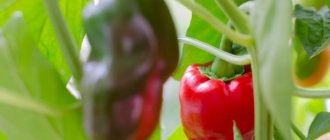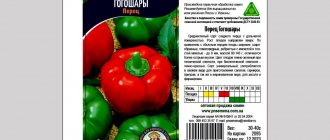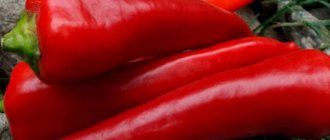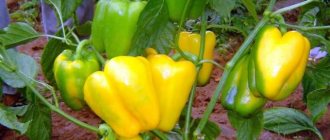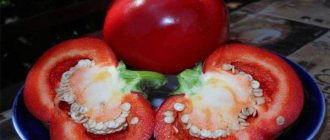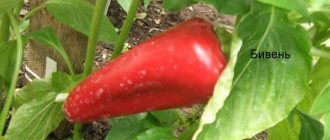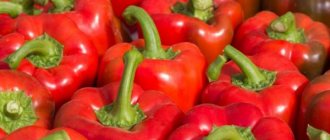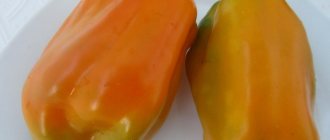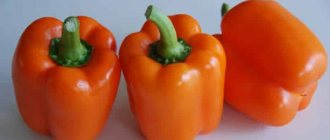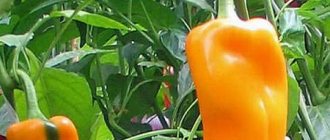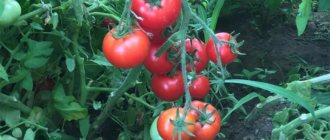Every year, gardeners make the difficult decision of which type of pepper to grow. Some people prefer to stay true to one variety. Others like to experiment and choose something new every time. If you haven't planted White Gold, now is the time to do so. An early-ripening plant with large fruits, the White Gold variety attracts attention with its appetizing appearance. The shape is cuboidal and the color is unusual, described by many as “pearl yellow”. The fruits of White Gold ripen on bushes up to 50 centimeters high after an average of 110 days from the start of cultivation (from the moment of sowing).
Important. Delays in maturation indicate improper care.
The fruits of the crop are surprising in size and weight, on average 450 grams maximum. Minimum weight – 230 grams. The walls of the fetus are dense - on average 10 millimeters. Salads with it become bright and incredibly healthy. This crop is also suitable for growing for those who like to preserve peppers.
Experienced gardeners grow White Gold for sale. There's a good reason. It should be noted that the variety can be stored for a long time, which means it is easy to transport over long distances. There is no need to worry that the fruits lose their attractive appearance and taste. Large and juicy, peppers of this variety have a good chance of helping the gardener achieve the desired result in the commercial sphere.
This crop is easy to grow. It is grown in greenhouse conditions, open ground. The variety will give good fertility if the care regime is proper.
You may be interested in: Favorable days for picking pepper in 2021 according to the lunar calendar Favorable days for planting pepper for seedlings in 2021: terms and rules for sowing at home Favorable days for sowing sweet and bitter pepper for seedlings in 2021
What type of pepper is this?
The variety was included in the State Register in 2009. It got its name due to the bright color of the fruits, which stand out noticeably in the beds.
White gold is an early-ripening crop, despite the large size of the peppers. Technical ripeness occurs 100–110 days after the appearance of the first shoots.
Characteristics and description
The variety has smooth and neat bushes with straight stems and slightly wrinkled middle leaves. The plants reach a height of 50 cm. The trunk is durable and can withstand large fruits.
The variety is recommended for cultivation in all regions of Russia, in open and closed ground.
Distinctive features
The main feature of pepper is the bright yellow color of the fruit. Often, as they grow, they acquire pearly shades.
Compared to other varieties, White Gold ripens much earlier, and some peppers reach particularly large sizes.
Fruit characteristics and yield
The fruits are cube-shaped with a faint glossy sheen. At the technical stage of ripeness, peppers are greenish-white in color, and at the biological stage they are pearly yellow. The vegetables are dense and fleshy: their walls reach 1 cm. The average weight of the fruit is 200–250 g, but some reach 500 g.
Subject to proper agricultural practices, farmers harvest up to 15 kg of crop per 1 m2 in open ground or a greenhouse.
The taste of peppers is sweetish with spicy notes, so the culture is great for salads.
Description and characteristics of the variety
Sweet pepper White Gold of the Siberian Garden company was bred by Russian breeders. The variety is intended for open ground and greenhouse cultivation. Although pepper is endowed with cold resistance and is adapted to the conditions of northern regions, in the north it is recommended to grow the crop in a greenhouse.
The bush is medium-sized, closer to low-growing: from 45 to 60 cm in height. The leaves are large, the stem is powerful and rarely requires tying. The variety is early ripening - the first harvest is harvested 110 days after germination.
The fruits are very large, their minimum weight is 200–250 g, but with abundant feeding, watering and careful care, peppers will weigh 450–500 g each. Their shape is cubic and their color is bright yellow. The walls of the fruit are thick - about 10 mm. The pepper is meaty, juicy, with excellent taste.
The taste of the pulp is sweetish-spicy, aromatic. Universal use: for canning, cooking and fresh dishes. The fruits have high commercial qualities.
Preparation for cultivation
Before planting the seeds, they are soaked in a nutrient solution (20 g of wood ash per 1 liter of water). The mixture is left in the growth stimulator for 24 hours, the seeds are placed in it in a fabric bag for 5 hours, then dried on a sheet of paper.
Attention! For the best effect, the seeds are disinfected in a solution of potassium permanganate before soaking.
For peppers, use fertile light soil made from leaf or turf soil, peat, sand (1:1:1) and a small amount of wood ash. The soil is disinfected by steaming a month before planting the crop (do this for several hours in a water bath, under a tightly closed lid).
Growing seedlings
Pepper seeds are planted 60–70 days before planting in the ground. Place in a deep container at a distance of 1-3 cm from each other, the grooves themselves are made no deeper than 1 cm. After planting, the container is covered with film and left in a warm place until the first shoots appear.
As soon as real leaves are formed, the seedlings are planted in separate pots. Do this carefully so as not to damage the roots:
- Compact the soil in the containers, dig a hole in the center and water it.
- Carefully remove the seedling using a spatula or spoon. If several plants are removed at the same time, the strongest and most developed ones are picked first.
- Place the plant in the hole so that the roots are free and even in the soil. In this case, the planting depth is left at the same level as before the pick.
- The soil around the seedling is carefully compacted.
- Water the plants at the roots with a small amount of water.
To avoid picking, the seeds are immediately planted in plastic flower pots (1 liter capacity), 3 pieces at a distance of 1-2 cm from each other, placing a triangle in the center of the container.
Water the seedlings with warm water as the soil dries, but without over-wetting it. Don't forget to apply fertilizer during irrigation. Calcium nitrate gives excellent results.
Important! Ready-made soil is chosen only of high quality, which will have a positive effect on the development of the crop.
An important aspect of growing is lighting. To avoid sprouts stretching, they are provided with the maximum amount of light. If there is a shortage of it, phytolamps are installed.
Attention is paid to hardening future peppers. A week before picking the seedlings, they are taken outside and left for 30 minutes, gradually increasing the time.
Planting pepper
When the seedlings have finally grown stronger, they are transplanted to a permanent place: in open ground or in a greenhouse. As a rule, this is done at the end of May, but cultivation in a greenhouse begins earlier. The culture is transferred to open ground on a cloudy day or in the evening. The soil is moistened abundantly.
For the full development of the crop, the soil on the site must be well heated (soil temperature - not lower than +10...+12 °C). There are no more than 5 bushes per 1 m2 of land, otherwise they will interfere with each other’s development. Dig holes according to the pattern: 30 by 50 cm.
At the initial stage, plants are fed with complex products. During the entire growing season, fertilizers are applied 3 times.
Attention! Fertilizing White Gold with manure will lead to active development of bushes in the leaves and a low number of ovaries. As a result, the fruits will be small in size.
Further care
Caring for the variety is not particularly difficult. It is enough to regularly water the plants, care for the soil, feed the crop and form bushes.
For irrigation, use warm, settled water (not lower than +14 °C). Drip irrigation is best when the soil does not dry out or become waterlogged. Irrigate the soil moderately, 2 times a day. Afterwards, the soil is loosened shallowly and weeds are systematically removed. The ground around the bushes is mulched with grass, sawdust or hay.
Phosphorus-potassium compounds and ash infusions are used as fertilizers. Fertilizers are applied once every 2 weeks.
When tying up bushes, supports are installed for them. Shoots are fixed to them to reduce the risk of stems breaking. Flowers and weak ovaries are cut off, and the tops of plants above 20 cm are pinched. They get rid of stepsons growing below the fork and inside the ovaries. The main bud at the branching site is removed to enhance the growth of the pepper.
Pepper White Gold: characteristics and description of the variety, photo, yield, cultivation and care
If you cannot decide on the variety of bell pepper to grow in your summer cottage, opt for the universal variety White Gold. This is one of the most popular early varieties with yellow juicy fruits. Read more about the qualities of this unique culture, as well as the peculiarities of its cultivation, in this article.
History and description of the variety
White Gold pepper received its name due to the fact that in the garden it stands out among other vegetable crops with its bright color. This crop is characterized by the following varietal characteristics.
Selection
The variety was bred by Russian breeders specifically for cultivation in the northern regions.
Fruit characteristics
The fruits are cubic in shape, quite large, the weight of individual specimens reaches 200–250 g, and some fruits even weigh 500 g or more.
During the process of ripening, the fruit changes its color: in the technical ripeness phase it is light yellow, slightly whitish, and ripe peppers are painted in an intense pearl-yellow tone.
The taste of the vegetable is delicate, with a pleasant aroma. The pulp is juicy, the wall thickness reaches 10 mm.
Due to the thick skin, the fruits can maintain their freshness for a long period, including during transportation. The fruits of White Gold are universal in use: they can be eaten fresh in salads, subjected to heat treatment for preparing various dishes, and the dense structure of the pulp allows them to be prepared as high-quality preserves.
Characteristics of the bush
The bush is compact, medium-sized, reaches a height of 50 cm. The trunk is durable and can easily withstand a lot of heavy fruits. The medium-sized leaves are slightly wrinkled and light green in color.
The presented culture belongs to the group of early ripening varieties. Technical maturity occurs 100–110 days after the sprouts appear; the fruits in this phase can already be consumed. After 2 weeks, the phase of biological maturity begins.
When grown in an open area, you can harvest 4.2 kg of peppers per 1 m².
Advantages and disadvantages
- Among the benefits of White Gold pepper, farmers note:
- good yield;
- high commercial qualities - especially large, thick-walled fruits with rich color and wonderful taste;
- ease of care, which is accessible even to novice summer residents;
- strong and compact bushes;
- versatility of use;
- keeping quality and transportability of fruits.
The variety has virtually no disadvantages. The only caveat is that to get an early and stable harvest, you cannot do without shelter, at least in early spring. Also, the plant needs at least 2-3 feedings during the entire growing season.
How to grow seedlings at home
Like most pepper varieties, White Gold is cultivated using seedlings. It is quite easy to grow young bushes at home.
Important! For preventive purposes, to avoid infections, seeds must be disinfected in a 1% solution of potassium permanganate or other disinfectants before sowing. After disinfection, rinse the seeds in warm water.
Deadlines
The optimal time for sowing seeds for seedlings is the end of February. As a last resort, sowing can be done in early spring.
The soil
To obtain strong seedlings, it is necessary to first prepare high-quality soil. It should be fertile, but at the same time light and breathable. When preparing the soil yourself, mix turf soil and humus or compost, add ash and mineral fertilizers. To add looseness to clay soil, add sawdust or sand.
Suitable acidity for growing pepper is about 6.4 pH. Before sowing, the soil mixture must undergo a disinfection procedure. Treat it with a solution of potassium permanganate (1-2%), after which additional treatment with a biological preparation (Trichodermin or Planriz) is recommended.
If the soil was taken from the garden, water it with a fungicide solution (for example, Fitosporin).
Capacity
You can use any container for sowing seeds, but it is better to plant them in large boxes. The container should have several drain holes - they will provide comfortable conditions for the young root system.
Seed selection and preparation
In order for the seedlings to germinate successfully, the choice of seeds should be approached responsibly. When purchasing planting material, study the packaging - it must indicate in what natural and climatic environment this type of pepper can be grown, the time of seed ripening and sowing rules. Also pay attention to the manufacturer, giving preference to a well-known company.
Important! When growing White Gold pepper seedlings, it is especially important to protect the tender sprouts from temperature changes. Optimal temperature for seed germination
—
+20…+25°С.
Additional soak clean seed material in a growth stimulator (wood ash or organomineral fertilizer “Effekton”). Prepared seeds can be germinated by keeping them in a damp cloth for some time at a temperature of +25...+27°C. The procedure will help speed up the emergence of seedlings.
Sowing seeds
Sowing is carried out in holes whose depth does not exceed 1 cm, after which the future seedlings need to be watered and covered with polyethylene film. The distance between the holes is 2–3 cm. Leave the container with the seeds in a warm place until the first shoots appear.
Seedling care
The emerging White Gold sprouts require maximum lighting - the light will help prevent the sprouts from stretching. If there is a lack of natural light, use artificial sources.
To increase immunity and resistance to future external threats, plants need to be hardened off.
Start the procedure 1 week before planting: take the box with the plants outside and leave it there for no longer than a few minutes to begin with.
Gradually, the time the seedlings spend outside needs to be increased. Water young bushes with warm water as the top layer of soil dries. Try not to over-wet the soil.
Apply fertilizers at the same time as watering. Feeding is carried out 1–2 times during the entire period of growing seedlings. Fertilizer with calcium nitrate gives good results.
With the appearance of several true leaves, pepper seedlings need to be planted in separate containers.
How to transplant seedlings to a permanent place
When the pepper seedlings have grown and become stronger, it is necessary to transplant them into the most comfortable environment for this plant, while observing the timing and planting pattern.
Site selection and crop rotation
Choose a place to transplant peppers taking into account crop rotation - this vegetable can be planted in the old place or after other nightshade crops no earlier than 3-4 years later. The best predecessors for peppers are carrots, early cabbage, legumes (except beans) and perennial herbs.
The site should be sunny and protected from winds. It is worth making sure that there is no groundwater nearby or a large body of water. If the groundwater level is high, raise the bed above the ground to a height of 30–35 cm, fencing it with boards.
Important! When planting sweet peppers in open ground, it is necessary to have a supply of covering material in case of unexpected frosts.
As a cover, you can use film and arcs, spunbond.
Planting pattern and depth
Transplant White Gold seedlings using the following technology:
- Before planting young plants, moisten and feed the land well - fill the holes with wood ash, rotted compost, and mineral fertilizers.
- Place the holes according to a 30x50 cm pattern and moisten them.
- Do not plant bushes below the level at which they grew in containers.
- After planting, moisten the plants again.
How to care for plantings
Caring for White Gold peppers is not too labor intensive. Bushes require regular watering, proper feeding, soil care and careful shaping.
Watering
Water the plantings periodically (at least 2 times a week). Use only warm water, since peppers respond negatively to water whose temperature is below +14°C. The ideal type of irrigation for the presented variety is drip.
Find out more about how to properly water peppers in a greenhouse.
Soil care
After each watering, loosen the soil shallowly. Do not loosen deeply so as not to disturb the root system of the plants. It is important to keep the plantings clean and get rid of weeds in a timely manner. To protect the soil from drying out and prevent weeds from breaking through, mulch the soil around the bushes. The best mulch is weeded grass, sawdust, and hay.
Fertilizer application
After the bushes have adapted, you need to feed them with liquid fertilizers, such as infusions of grass and mullein, diluted with water. Additionally, use phosphorus-potassium compounds and ash infusions. Apply fertilizers to moist soil once every 2 weeks.
Garter bushes
Despite the fact that the bushes of this variety are quite strong, it is better to install supports for them when planting. Tie the shoots to supports to reduce the risk of stems breaking. At the end of the season, regulate the harvest by cutting off flowers and poorly developed ovaries. Pruning will allow existing fruits to ripen. For better tillering, when the plant reaches a height of 20 cm, the tops should be pinched.
Subsequent formation involves removing the stepsons that grow below the fork, as well as weak ovaries growing inward.
To prevent weakening of growth, pluck out the main bud, which is located at the branching site. As you can see, White Gold pepper has a lot of advantages.
Even a novice summer resident will be able to cope with growing the described variety. These bright vegetables will delight you with their unpretentiousness, abundant harvest and excellent taste.
Source: https://fermer.blog/bok/ogorod/perec/sorta-perca/sladkiy-perec/rannie-sorta-perca/2861-sort-sladkogo-perca-beloe-zoloto.html
Features of cultivation and possible difficulties
The most suitable regions for cultivating the variety are the regions of central Russia. Pepper grows well both in open ground and in greenhouse conditions. However, in harsh climates (in the Urals and Siberia), the crop is planted in greenhouses.
Attention! To get a rich harvest, pollinating insects are attracted. To do this, use a solution of 2 g of boric acid, 1 liter of water and 100 g of granulated sugar, which is sprayed on the bushes.
Seedlings are planted at the age of 65–70 days in order to have time to get a harvest in short summer conditions.
Description of the variety
The peppers are large and ripen quite early. It grows in the form of small neat shrubs no more than 45-60 cm high. The stem of the plant is straight and strong, and the leaves are smooth and large. The fruits have a large cubic shape. The structure of the walls of the vegetable is fleshy, juicy and reaches a width of 1 cm. The weight of peppers ranges from 200 g to 450 g. The color of mature peppers is predominantly bright yellow, and during the formation process it becomes pearly. In breeding, this variety is considered one of the best; it is chosen for cultivation more often than other varieties.
Pepper is rich in useful microelements and substances of their own chemical composition such as phosphorus, potassium, ascorbic acid, pectin, fiber, iron, calcium, sucrose, as well as vitamins C, B, PP, A, E and essential oils. The average calorie content of the fruit is 27-30 kcal/100 g. The fruits of yellow pepper have a sweetish-spicy taste. During transportation, the vegetable does not lose its taste and external qualities due to its dense walls.
Typical diseases and pests
The White Gold variety is resistant not only to the tobacco mosaic virus, but also to most other diseases. However, when the shape and color of plant leaves change, spots appear on them and growth is inhibited, the crop is treated with special preparations: “Fitosporin” or Bordeaux mixture.
Frequent pests of pepper are aphids, wireworms and spider mites . Infusions of garlic, tobacco or birch tar repel aphids and ticks, and wireworms are caught using fruit baits.
Advantages and disadvantages of the variety
White Gold Pepper has virtually no downsides. The only negative is the need to cover the plants with special material at least in early spring.
Benefits of culture:
- bushes of neat shape and small size;
- simplicity of agricultural technology;
- large tasty fruits;
- high productivity;
- versatility of use;
- long-term preservation of fruits in marketable condition;
- good transportability.
Reviews from gardeners
Both professional farmers and ordinary summer residents have already tried white gold on their plots. They are happy to leave their feedback so that other gardeners can see their practical results. In particular, a resident of Bryansk notes that the use of any pesticides in the garden beds negatively affects the taste of pepper fruits. The plant already has excellent resistance to many pathogens, but for prevention purposes it is better to use folk remedies.
A resident of Nizhny Novgorod is also a supporter of environmentally friendly products and tries to avoid the use of chemicals when growing peppers. As a result, in a small area she gets excellent yields of White Gold pepper - there are enough fruits not only for preparing dishes during the summer season, but also for preparing food for the winter.
Reviews
Due to its characteristics, White Gold is considered one of the best varieties in selection. Numerous enthusiastic reviews from gardeners only confirm this fact.
Evgeniy, Bryansk: “I have been growing the White Gold variety for several years now and I want to give only one piece of advice: do not use pesticides. They will not improve the taste of vegetables, but will increase the risk of poisoning. This pepper variety is strong and can cope with diseases on its own.”
Nina, Moscow: “I love thick-walled varieties for their juiciness and texture. In my opinion, this is the best option for salads. In the summer, not a single meal is complete without White Gold pepper. I’ve never been canning before, but the variety produces such a rich harvest that I’m starting to think about it.”
Lyudmila, Voronezh: “I have been growing White Gold in a greenhouse for a long time and am convinced that this is one of the best varieties of large yellow peppers. Many people believe that early ripening crops need special care, but I don’t think so. There is nothing complicated in the agricultural technology of vegetables, and the result surprises again and again.”
Under what conditions will White Gold pepper take root and why do summer residents love it?
Yellow peppers are rightfully considered the most delicious and juicy. Gardeners try to allocate space in the beds for at least one such variety. White Gold pepper has earned popularity not only due to its excellent taste characteristics, but also because of its unusually beautiful and bright appearance and strong aroma. It is easy to notice among other crops on the site.
Russian breeders worked on developing the White Gold variety. Initially, it was supposed to be grown in northern regions with difficult climatic conditions, but over time, gardeners from other regions also liked the variety.
